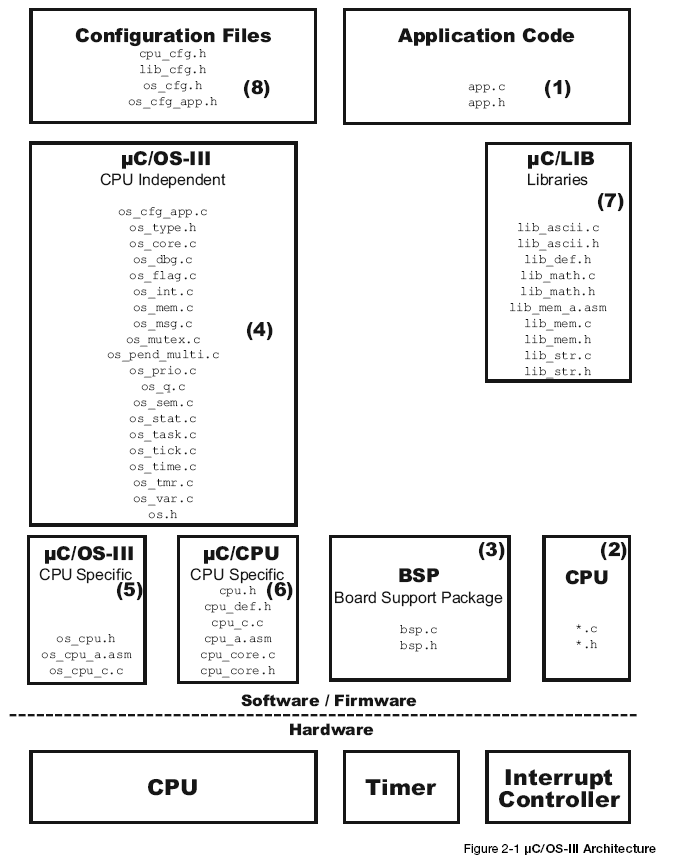Notes for uc/OS-III User Guide
1. Architecture

F2-1(1) The application code consists of project or product files. For convenience, these are simply called app.c and app.h, however an application can contain any number of files that do not have to be called app.*. The application code is typically where one would find the main().
F2-1(2) Semiconductor manufacturers often provide library functions in source form for accessing the peripherals on their CPU or MCU. These libraries are quite useful and often save valuable time. Since there is no naming convention for these files, *.c and *.h are assumed.
F2-1(3) The Board Support Package (BSP) is code that is typically written to interface to peripherals on a target board. For example such code can turn on and off LEDs, turn on and off relays, or read switches, temperature sensors, and more.
F2-1(4) This is the μC/OS-III processor-independent code. This code is written in highly portable ANSI C.
F2-1(5) This is the μC/OS-III code that is adapted to a specific CPU architecture and is called a port. μC/OS-III has its roots in μC/OS-II and benefits from being able to use most of the 45 or so ports available for μC/OS-II. μC/OS-II ports, however, will require small changes to work with μC/OS-III. These changes are described in Appendix C, “Migrating from μC/OS-II to μC/OS-III” on page 697.
F2-1(6) At Micriμm, we encapsulate CPU functionality. These files define functions to disable and enable interrupts, CPU_??? data types to be independent of the CPU and compiler used, and many more functions.
F2-1(7) μC/LIB is of a series of source files that provide common functions such as memory copy, string, and ASCII-related functions. Some are occasionally used to replace stdlib functions provided by the compiler. The files are provided to ensure that they are fully portable from application to application and especially, from compiler to compiler. μC/OS-III does not use these files, but μC/CPU does.
F2-1(8) Configuration files are used to define μC/OS-III features (os_cfg.h) to include in the application, specify the size of certain variables and data structures expected by μC/OS-III (os_cfg_app.h), such as idle task stack size, tick rate, size of the message pool, configure the μC/CPU features available to the application programmer (cpu_cfg.h) and also configure μC/LIB options (lib_cfg.h).
Notes for uc/OS-III User Guide的更多相关文章
- uc/os iii移植到STM32F4---IAR开发环境
也许是先入为主的原因,时钟用不惯Keil环境,大多数的教程都是拿keil写的,尝试将官方的uc/os iii 移植到IAR环境. 1.首先尝试从官网上下载的官方移植的代码,编译通过,但是执行会报堆栈溢 ...
- uC/OS - III 移植 IAR平台
关于移植uC/OS-III 网上已经有很多教程了此处只是做个记录 首先下载源码然后解压得到下面的文件: 然后在模版工程里新建各种文件夹: 最后全部都添加进工程: OK了,编译一下,惊呆了,竟然 0错误 ...
- uC/OS II原理分析及源码阅读(一)
uC/OS II(Micro Control Operation System Two)是一个可以基于ROM运行的.可裁减的.抢占式.实时多任务内核,具有高度可移植性,特别适合于微处理器和控制器,是和 ...
- uc/os 任务删除
问题描述: uc/os 任务删除 问题解决: uc/os任务删除流程图 具体代码 注: 如上是关中断,以及取消优先级对应的就绪标志 关中断代码为: 取消就绪标志,实际上是将就绪表中指定 ...
- uc/os任务创建
问题描述: uc/os中任务创建 问题解决: 创建一个任务,任务从无到有.任务创建函数分两种, 一种是基本的创建函数OSTaskCreate, 另一种是扩展的任务创建函数OSTaskCrea ...
- uC/OS 的任务调度解析 (转)
uC/OS 的任务调度解析 1.任务调度器启动之后(初始化,主要是TCB的初始化),就可以创建任务,开始任务调度了,实际上第一个任务准确的说不是进行任务切换,而是进行启动当前最高优先级任务.uC/OS ...
- 关于uC/OS的简单学习(转)
1.微内核 与Linux的首要区别是,它是一个微内核,内核所实现的功能非常简单,主要包括: 一些通用函数,如TaskCreate(),OSMutexPend(),OSQPost()等. 中断处理函数, ...
- STM32F40G-EVAL_UC/OS III
micrum官网下载uc/os程序包: 包含文件cotex_M4.h:
- 【原创】uC/OS 中LES BX,DWORD PTR DS:_OSTCBCur的作用及原理
LES BX, DWORD PTR DS:_OSTCBCur ;OSTCBCur->OSTCBStkPtr = SS:SP!!! ], SS ;将当前SS(栈的基地址)寄存器值存放至当前任务控制 ...
- 【原创】uC/OS II 任务切换原理
今天学习了uC/OS II的任务切换,知道要实现任务的切换,要将原先任务的寄存器压入任务堆栈,再将新任务中任务堆栈的寄存器内容弹出到CPU的寄存器,其中的CS.IP寄存器没有出栈和入栈指令,所以只能引 ...
随机推荐
- Ubuntu访问samba共享文件
Ubuntu访问samba共享文件 参考:https://www.cnblogs.com/Wolf-Dreams/p/11241198.html 做法 安装samba-client.cifs-util ...
- 分享两个内置Google广告位的Typecho主题
前言 很多项目的开始都是因为情怀和热爱,"为爱发电"是一件很值得尊敬的事情,然而大量"为爱发电"的项目最后却不得不因"难以为继"而被迫停服. ...
- SpringMVC原理(1)-文件上传请求
我们文件上传接口只需要在方法参数上写MultipartFile类,mvc就可以帮我们把上传的文件封装为这个类的对 象供我们非常方便的操作,那它是怎么做的呢?我们一起来看看 我们发的请求默认都是由Dis ...
- k8s实战 ---- pod 基础
如果你对k8s还不了解,可以看下前文 k8s 实战 1 ---- 初识 (https://www.cnblogs.com/jilodream/p/18245222) 什么是pod,pod在 ...
- 韦东山freeRTOS系列教程之【第七章】互斥量(mutex)
目录 系列教程总目录 概述 7.1 互斥量的使用场合 7.2 互斥量函数 7.2.1 创建 7.2.2 其他函数 7.3 示例15: 互斥量基本使用 7.4 示例16: 谁上锁就由谁解锁? 7.5 示 ...
- VUE商城项目 -权限功能 - 手稿
- javaweb上传图片存到本地,并存储地址到数据库
前端使用layui的图片上传,将文件base64编码,然后在后端使用转码类来操作base64编码,并保存图片到本地,继而获取文件地址,将文件地址保存到数据库中 1.使用layui的图片上传 infos ...
- openStack核心组件的工作流程
目录 openStack核心组件的工作流程 1. Keystone 1.1 User 1.2 Credentials 1.3 Authentication 1.4 Token 1.5 Project ...
- Vue 中引用第三方js总结
vue中引用第三方js总结 By:授客 QQ:1033553122 实践环境 win10 Vue 2.9.6 本文以引用jsmind为例,讲解怎么在vue中引用第三方js类库 基础示例 1.把下载好的 ...
- FindBugs质量管理
1. FindBugs是什么 FindBugs 是一个静态分析工具,它检查类或者 JAR 文件,将字节码与一组缺陷模式进行对比以发现可能的问题.有了静态分析工具,就可以在不实际运行程序的情况对软件进行 ...
